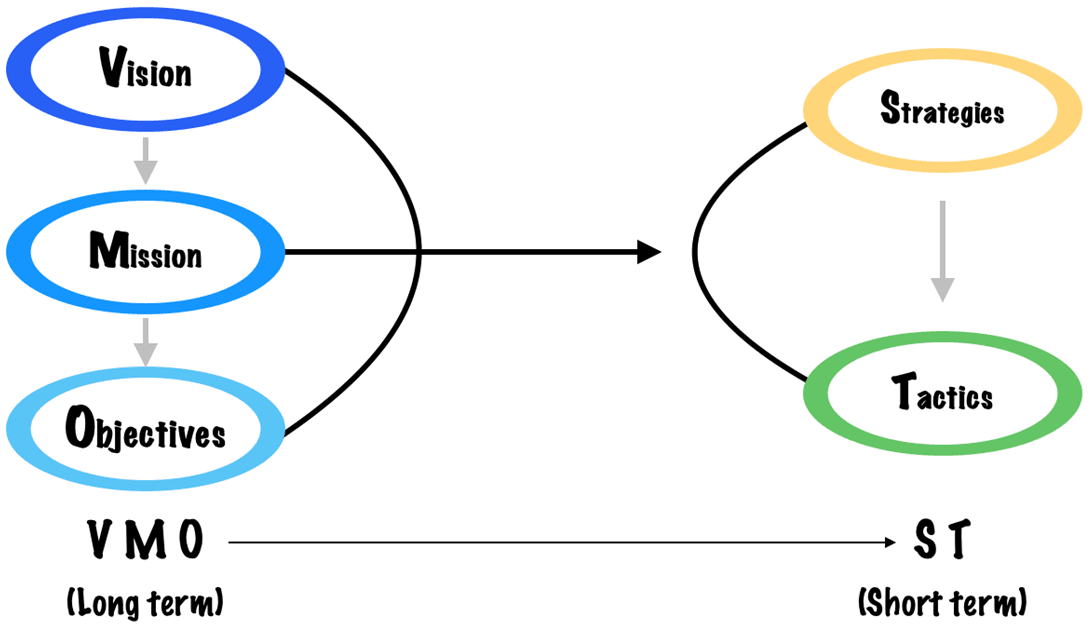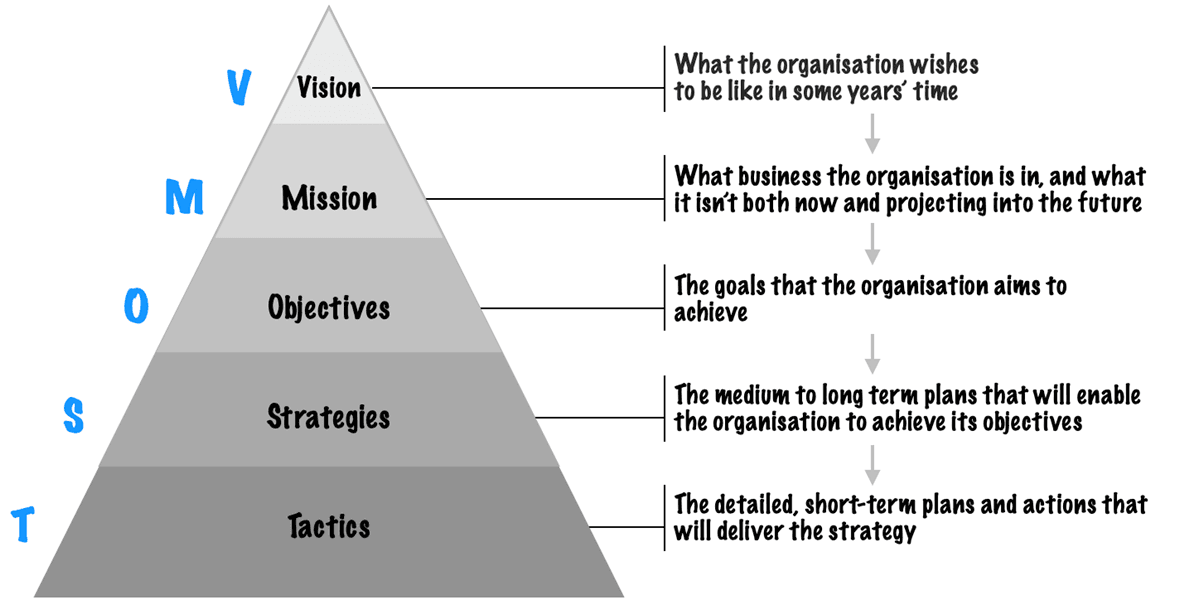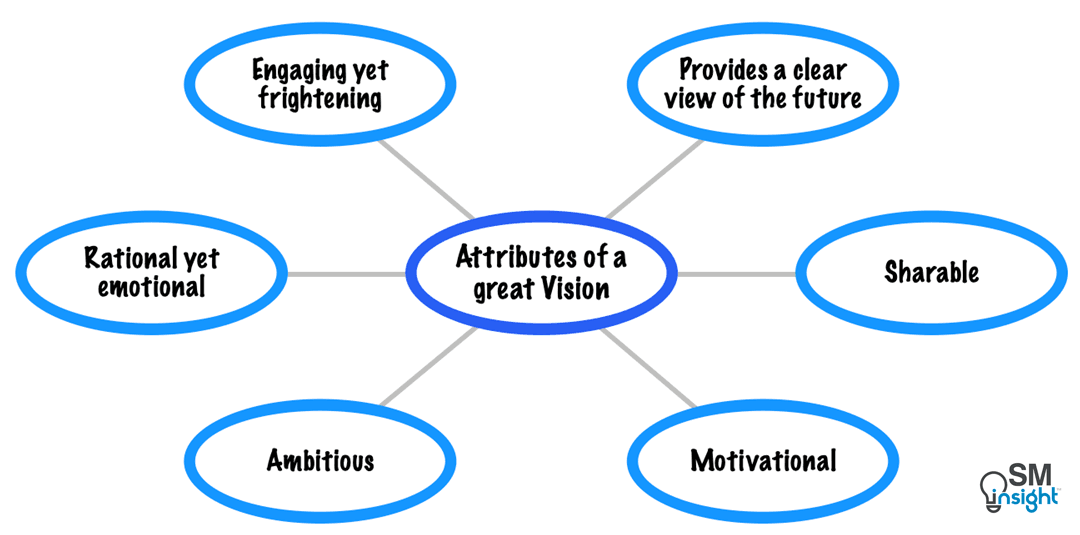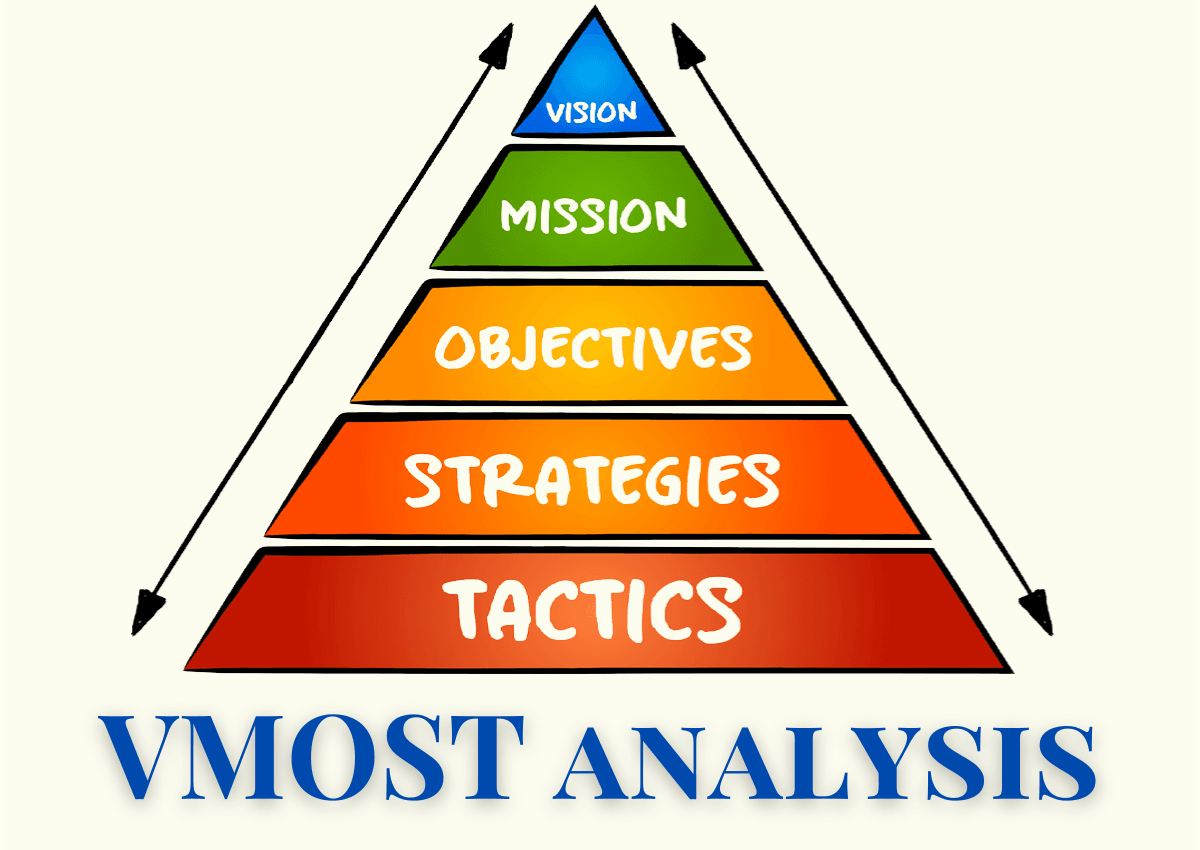The most enduring management guru of them all, Peter Ducker, said, “Management is doing things right; leadership is doing the right things.”
VMOST is an analysis technique that helps organizations do both. It helps effectively articulate what they have set out to achieve (Vision, Mission, and Objectives) and connect it to how they aim to achieve them (Strategy and Tactics).
An organization’s vision, mission, and objectives focus on the long-term and are set by the direction it aims to pursue. These elements, in turn, shape the organization’s strategy and tactics, which focus on the short term and specify how day-to-day activities are carried out.

Aligning long-term priorities with short-term actions is challenging. A misalignment can either slow progress or prevent an organization from achieving its vision entirely.
VMOST helps avoid misalignments by analyzing what an organization has set out to achieve and connecting it to how it aims to achieve it. It provides a statement of intent for the organization and helps embed that intent into day-to-day actions.
VMOST was first proposed by Rakesh Sondhi in 1999 in his book Total Strategy [1].
The goal of the VMOST is to enable a view of strategy (S) translated into meaningful terms for the benefit of employees, customers, and all other stakeholders by expressing it in the form of visions (V), missions (M), objectives (O) and tactics (T).
Five layers of VMOST
In most organizations, business intent and strategy are often informally expressed in written documents such as business plans or in casual language during a business manager’s explanations in interviews or meetings.
VMOST brings structure to this through its five components (or layers), which can be visualized in a pyramidal hierarchy:

These five VMOST components force an organization to examine its short-term plans and actions in the context of its broader vision, mission, and long-term goals. It helps evaluate the overall strategy and supporting activities and determine whether they align.
Performing VMOST analysis
VMOST analysis aims to identify strengths and weaknesses in an organization across the following four areas:
- Definition: Is there a defined VMOST for the organization? Is it complete and consistent, or are elements missing or out of alignment?
- Clarity: Does the organization’s VMOST set a clear direction and plan to enable its development and provide a focus for work?
- Communication: Are the organization’s employees aware of the VMOST, and is it available as a context for their work?
- Organizational commitment: Do the staff work to deliver the VMOST? Do they agree with its content and support its intent?
Through a set of interrogative questions or queries, VMOST analysis forces organizations to specifically call out and discuss their Vision, Mission, Objectives, Strategy, and Tactics.
VMOST analysis consists of the following steps:
1. Define The Scope Of The Analysis
VMOST Analysis begins by determining the scope, which could cover the entire organization’s strategy and activities or a specific business unit.
The analysis could even be limited to how a particular project team or individual contributes to achieving the organization’s vision.
2. Formulate The Vision
A well-defined vision that everyone understands clearly is at the heart of an organization’s strategy and provides the aspirational goal required to make progress.
Vision answers what the organization wants to become and is usually a one-sentence, inspirational, clear, and memorable statement that expresses the desired long-term position of the organization.
A vision must be attractive and provide a clear view of the future which can be shared. It must motivate, be ambitious, and stretch people to achieve more than they thought was possible.
Consequently, vision is the critical driver in the VMOST process – every other element orients itself toward fulfilling the goals espoused by the vision. A variety of tools can help articulate vision – popular ones include:
| Tool / Framework | Purpose |
|---|---|
| SWOT Analysis [2] | To craft a vision that realistically considers the organization’s strengths, weaknesses, opportunities, and threats. |
| PESTLE Analysis [3] | To consider the Political, Economic, Social, Technological, Legal and Environmental realities that could impact vision attainment. |
| Scenario Planning [4] | To envision possible future scenarios and the impact they can have on vision. |
| Vision Workshops | Facilitated sessions to collaboratively define vision which is important for organization-wide buy-in. |
| Mind Mapping [5] | To visually organize ideas and concepts related to the vision. |
| Future Wheel Analysis [6] | To explore the potential consequences of changes. |
| Gap Analysis [7] | To determine the gap between the current state and vision. |
According to Sondhi, vision should have the following key attributes:

- Provide a clear view of the future—it needs to be easy to understand and enable recipients to see the future being aimed for.
- Be shared—must be shared and believed by everyone in the organization.
- Be motivational—must become the vehicle to motivate and inspire individuals to achieve more than what’s otherwise possible.
- Be ambitious—should force people to push themselves that little bit further, without necessarily ever reaching the ultimate goal.
- Be rational yet emotional—commitment is gained by latching onto individuals’ emotions. Good vision must identify the drivers that will switch the commitment on.
- Be both engaging and frightening—fear ensures maximum performance. However, there is a boundary where fear can also negatively impact performance. Good vision must strike the right balance and motivate people toward performance to gain a competitive edge.
Learn more about how to craft vision statements in this dedicated article [8].
3. Analyze The Vision
Once the vision is defined, it must be tested for soundness. Ask the following question:
- To what extent is there a vision?
- How clear is this vision?
- Who owns the vision?
- Is the vision well communicated and shared by key people in the organization?
- Is the vision emotional and engaging?
- Is the vision distant yet achievable?
- Is the vision ambitious and stretching?
- How does the vision align with the industry trends and future market conditions?
- What unique impact will the vision have on the community or industry when realized?
- How is the organization’s vision linked to the global landscape?
These queries test the vision for definition, clarity, organizational commitment, and communication, which are vital to realizing the vision.
4. Identify or Formulate Mission Statement(s)
A mission statement describes what an organization does, what its business is, and why it does it [9]. It supports the vision and communicates purpose and direction to employees, customers, vendors, and other stakeholders.
According to Sondhi, mission empowers individuals by providing a guiding force that directs their behavior in a specific direction.
Mission statements reflect a company’s (or department’s) priorities and methods to accomplish its vision.
An organization can have several mission statements.
For example, a mission statement at a corporate or organization-wide level is typically strategic and more public relations-oriented. It usually focuses on “Why does this organization exist?”
In contrast, subsidiary or department-level mission statements are intended to be more motivational and staff-oriented. They usually address the question, “Why does my unit exist in relation to the broader vision and mission of the organization?”
When performing a VMOST Analysis, it is essential to identify mission statements appropriate to the defined scope.
An organization’s mission can change depending on success, environmental changes, an expanded concept of vision, etc. These changes are not failures but critical to ensuring that the mission aligns with the organization’s actions.
Sondhi provided several vital attributes for a good mission statement:

- Purpose—should indicate the primary justification for the organization’s existence.
- The principle aims—should convey the principle aims of the organization stated in terms of market share, profitability, pricing targets, or some other metric.
- Identity—must convey the organization’s link to a broader identity to which it wants to be related.
- Policies—should be based on the philosophy and style of leadership that the organization wishes to embody or demonstrate.
- Values—must reflect the values of the stakeholders it seeks to address as they relate to the organization.
Consider using the following tools and techniques in crafting mission statements:
| Tool / Framework | Purpose |
|---|---|
| Stake Holder Analysis [10] | To understand the needs and expectations of stakeholders and whether the mission reflects these realities |
| Value Proposition Canvas [11] | To understand how the mission links with the value that customers expect from the organization |
| Customer Journey Maps [12] | To visualize the customer touchpoints where value is generated and understand how the mission links with it |
| Core Competency Analysis [13] | To check if the mission acknowledges and leverage unique strengths of the organization |
| Benchmarking [14] | To check if the mission statement pushes the organization to excel with reference to industry standards and best practices |
| Ethnographic Research [15] | To check if the mission consistent with the needs of diverse user groups |
| Service Blueprinting [16] | To understand how the mission benefits processes and interactions from a customer’s perspective |
| CSR Frameworks | Frameworks such as Carroll’s pyramid of CSR [17], Tripple Bottom Line [18] that help organizations integrate social and environmental responsibilities into their mission |
Learn more about how to craft mission statements in this dedicated article [9].
5. Analyze Mission Statement(s)
Once the mission statement(s) is/are defined or identified, the next step in VMOST is to test it for soundness. Analyze by asking questions such as:
- Is there an explicit mission in the organization, or is there an implied mission?
- Is the mission actually a mission, or is it a goal? A mission must reflect an organization’s past and present by stating why it exists and its role in society. Goals are more specific aims the organization pursues to achieve its vision and mission.
- Is the mission appropriate and relevant for the vision and environment?
- What is the purpose of the mission? Is it for staff motivation or public relations? Is it successful?
- Does the mission provide a realistic view (from management’s perspective) of the organization’s capabilities?
- Does the mission express the organization’s policies and values? Do these align with the actual values identified in the culture analysis? Are the policies valid and relevant to the environment?
- How does our mission reflect our vision and values?
Sondhi stressed that organizations must seriously question the value of mission statements that require employees to use cards or other visual means to remember rather than fully committing to a set of values they believe in.
Evaluating mission statements for brevity and emotional appeal over specificity and detail is equally important.
6. Identify or Formulate Objectives
Objectives are goals that every organization must define to realize its mission. They are the criteria by which an organization knows when a mission has been achieved.
Objectives provide the specific steps to achieve the mission. Without them, a mission is just a statement that can never be attained with certainty. It is thus essential to set well-defined objectives that are measurable in some way.
Goal-setting is widely discussed in management, and various goal-setting frameworks are available. Some popular ones include:
| Tool | Purpose |
|---|---|
| SMART Goals Framework [19] | To ensure objectives are Specific, Measurable, Achievable, Relevant and Time-bound. |
| OKR (Objectives and Key Results) [20] | To align and track objectives with outcomes. |
| KPIs (Key Performance Indicators) [21] | To measure progress towards objectives. |
| Balanced Scorecard [22] | To expand objectives beyond financial metrics to reveal value drivers for superior long-term performance. |
| Locke and Latham’s 5 Principles Framework | Emphasizes Clarity, Challenge, Commitment, Feedback, and Task Complexity for effective objective setting. |
| BHAGs (Big Hairy Audacious Goals) Framework [24] | Describes how to set highly ambitious goals that require significant effort but push people beyond their comfort zones. |
| Milestone Planning | To identify key milestones in achieving objectives. |
Organizations can also explore more goal-setting frameworks and tools, including the goal question metric, WOOP (wish, outcome, obstacle, plan), golden circle, cascade goal-setting, critical success factors, ROCKs, One-Word goal-setting, and backward goal-setting.
A crucial step in VMOST analysis is to ensure every mission is associated with an objective.
7. Analyze the objectives
Analyze the objectives by asking the following questions:
- Are objectives specific, measurable, achievable, relevant, and time-bound?
- Do they help fulfill the mission?
- How will achieving these objectives move the organization closer to its vision?
- What key performance indicators (KPIs) will be used to track progress?
- Are objectives consistent and coherent with each other?
- Are there conflicts between them?
- Are objectives realistic given the organization’s external factors and internal strengths and weaknesses?
- Do objectives consider the interests of key stakeholders?
- Are objectives clear enough for everyone to understand? Do they know their role in accomplishing them?
Once objectives are scrutinized, the next step is to focus on strategy.
8. Identify or Formulate strategies
Every objective must be linked to one or more strategies that guide the organization’s workforce in achieving it.
Some of the popular tools for formulating business strategies include:
| Tool | Purpose |
|---|---|
| BCG Matrix [25] and Ansoff Matrix [26] | To prioritize business units or products. |
| Business Model Canvas [27] | To map out strategic business models. |
| Value Chain Analysis [28] | To identify value-adding activities. |
| Scenario Analysis [29] | To test strategic plans against different scenarios. |
| Porter’s three generic strategies [30] | Provides the foundation to set business-level strategies that bring a competitive advantage. |
A strategy does not have to be very specific regarding what actions, business, or product changes may be required to support an objective. This is usually considered when formulating tactics in the next step.
For example, the European Commission aims to reach net zero carbon emissions by 2050. Its strategy to achieve this includes increased investment and funding in industrial carbon management projects, boosting support for research and innovation, and cooperation with international partners on industrial carbon management [31].
A good strategy must ensure that objectives are achieved through optimal resource utilization, whether financial, physical, or human.
9. Analyze the strategy
Test the strategy using the following queries:
- What are the basic elements of the strategy?
- Do they align with the organization’s vision and mission?
- Can the strategy be effectively implemented in practice?
- How does it align with the market reality?
- How does it help differentiate the organization from others?
- Does it address the key risks and uncertainties around realizing the vision?
- How does it balance short-term gains with long-term sustainability?
10. Identify and Formulate Tactics
Tactics represent specific activities to move the strategy forward and achieve the objective.
Tactics may be business unit-specific or apply across the organization. Most importantly, some metrics should be identified to evaluate effectiveness so that they can be monitored and adjusted as necessary.
In the above example, the European Commission’s strategy to increase investment and funding to promote industrial carbon management projects could include tactics such as:
- Launching funds worth € XX million dedicated to carbon capture, utilization, and storage (CCUS).
- Facilitate and incentivize at least 10 partnerships between public institutions, private companies, and research organizations in 2025.
- Implement tax credits, rebates, and subsidies for industries investing in carbon reduction technologies, with a target of at least € XX million.
While more specific than a strategy, these tactics drive the EU Commission’s goal of implementing carbon management technologies.
11. Analyze the Tactics
Test tactics using the following queries:
- How does this tactic carry forward the strategy on a day-to-day basis?
- Does the tactic reflect the strategy’s aims?
- Are the tactics coordinated between different parts of the organization?
- Are the tactics being monitored for success?
- Do we have the resources needed to implement our tactics?
- Are appropriate budgets allocated to these tactics?
- Do our tactics have realistic timelines and milestones?
- How do we monitor and evaluate the effectiveness?
- Do employees understand these tactics well?
12. Check VMOST alignment
Once all five components of VMOST have been defined and identified, a final step is to check if they are aligned. Ask the following queries:
- Are they consistent with each other?
- Is there a conflict between the elements?
- Are there aspects of the vision or mission(s) unsupported by objectives, strategy, and tactics?
If misalignments are found, based on the analysis results, determine if changes should be made to the strategy or its elements. Those changes should address any issues that emerged from the VMOST Analysis process.
Result of VMOST analysis
Performing VMOST Analysis ensures that an organization’s strategy is consistent across all its elements and relevant to the current environment.
An organization’s answer to all of the following questions should be a “yes” after a VMOST analysis:
- Is there a defined VMOST for the organization or unit being analyzed?
- Is it complete and consistent?
- Do the VMOST results set out a clear direction and plan for the organization’s development and work?
- Are the organization’s staff aware of the VMOST and how it applies to their work?
- Do staff agree with the content of VMOST and support its intent?
Every “yes” to the above question is a strength; every “no” is a weakness.
For example, senior management may have defined the VMOST, but the staff might not agree with the direction and objectives and, as a result, not be motivated to deliver them, which is a weakness.
Advantages and Limitations
While VMOST’s hierarchical approach makes it relatively easy for all stakeholders to understand, it can be a tricky technique for assessing internal capability.
Merely defining and displaying a coherent VMOST does not necessarily result in buy-in and motivation across the organization. Real strength is gained when it provides the organization with focus and direction.
Without clarity or agreement, VMOST can mask fundamental weaknesses [32].
Sources
1. “Total Strategy”. Rakesh Sondhi, https://www.amazon.com/dp/0952884518. Accessed 28 Feb 2025.
2. “SWOT Analysis – How to Do It Properly”. Strategic Management Insight, https://strategicmanagementinsight.com/tools/swot-analysis-how-to-do-it/. Accessed 27 Feb 2025.
3. “PEST & PESTEL Analysis”. Strategic Management Insight, https://strategicmanagementinsight.com/tools/pest-pestel-analysis/. Accessed 27 Feb 2025.
4. “Scenario planning”. Wikipedia, https://en.wikipedia.org/wiki/Scenario_planning. Accessed 27 Feb 2025.
5. “Vision Crafting”. Michael J. Gelb, https://www.nightingale.com/newsletters/516/. Accessed 27 Feb 2025.
6. “What is Futures Wheel?”. Visual-paradigm, https://online.visual-paradigm.com/knowledge/decision-analysis/what-is-futures-wheel/. Accessed 27 Feb 2025.
7. “Gap Analysis”. Strategic Management Insight, https://strategicmanagementinsight.com/tools/gap-analysis/. Accessed 27 Feb 2025.
8. “Vision Statement”. Strategic Management Insight, https://strategicmanagementinsight.com/tools/vision-statement/. Accessed 28 Feb 2025.
9. “Mission Statement for Success”. Strategic Management Insight, https://strategicmanagementinsight.com/tools/mission-statement/. Accessed 27 Feb 2025.
10. “Stakeholder Analysis and Revising the Mission Statement”. Richard Kühn and Rudolf Grünig, https://www.researchgate.net/publication/324622450_Stakeholder_Analysis_and_Revising_the_Mission_Statement. Accessed 28 Feb 2025.
11. “https://www.designabetterbusiness.tools/tools/value-proposition-canvas”. DESIGNABETTERBUSINESS.TOOLS, https://www.designabetterbusiness.tools/tools/value-proposition-canvas,. Accessed 28 Feb 2025.
12. “Customer Journey Map (CJM)”. Strategic Management Insight, https://strategicmanagementinsight.com/tools/customer-journey-map/. Accessed 28 Feb 2025.
13. “Core Competencies in Business: Finding a Competitive Advantage”. Investopedia, https://www.investopedia.com/terms/c/core_competencies.asp. Accessed 28 Feb 2025.
14. “Benchmarking”. Strategic Management Insight, https://strategicmanagementinsight.com/tools/benchmarking/. Accessed 28 Feb 2025.
15. “Ethnographic Research”. Interaction Design Foundation, https://www.interaction-design.org/literature/topics/ethnographic-research. Accessed 28 Feb 2025.
16. “Service blueprint”. Wilipedia, https://en.wikipedia.org/wiki/Service_blueprint. Accessed 28 Feb 2025.
17. “Caroll’s CSR Pyramid: principles and examples”. Greenly, https://greenly.earth/en-gb/blog/company-guide/carolls-csr-pyramid-principles-and-examples. Accessed 28 Feb 2025.
18. “Triple Bottom Line”. Strategic Management Insight, https://strategicmanagementinsight.com/tools/triple-bottom-line/. Accessed 28 Feb 2025.
19. “The Ultimate Guide To S.M.A.R.T. Goals”. Forbes, https://www.forbes.com/advisor/business/smart-goals/. Accessed 28 Feb 2025.
20. “Objectives and Key Results (OKRs)”. Bain, https://www.bain.com/insights/management-tools-objectives-and-key-results/. Accessed 28 Feb 2025.
21. “KPIs: What Are Key Performance Indicators? Types and Examples”. Investopedia, https://www.investopedia.com/terms/k/kpi.asp. Accessed 28 Feb 2025.
22. “Balanced Scorecard”. Strategic Management Insight, https://strategicmanagementinsight.com/tools/balanced-scorecard/. Accessed 28 Feb 2025.
23. “A Theory of Goal Setting & Task Performance”. Edwin Locke and Gary Latham, https://www.researchgate.net/publication/232501090_A_Theory_of_Goal_Setting_Task_Performance. Accessed 28 Feb 2025.
24. “What Is a Big Hairy Audacious Goal (BHAG)”. Investopedia, https://www.investopedia.com/terms/b/big-hairy-audacious-goal-bhag.asp. Accessed 28 Feb 2025.
25. “Boston Consulting Group (BCG) Growth-Share Matrix”. Strategic Management Insight, https://strategicmanagementinsight.com/tools/bcg-matrix-growth-share/. Accessed 28 Feb 2025.
26. “Ansoff Matrix Explained”. Strategic Management Insight, https://strategicmanagementinsight.com/tools/ansoff-matrix/. Accessed 28 Feb 2025.
27. “Business Model Canvas (BMC)”. Strategic Management Insight, https://strategicmanagementinsight.com/tools/business-model-canvas-bmc/. Accessed 28 Feb 2025.
28. “Value Chain Analysis”. Strategic Management Insight, https://strategicmanagementinsight.com/tools/value-chain-analysis/. Accessed 28 Feb 2025.
29. “Scenario Planning and Strategic Forecasting.” Forbes, https://www.forbes.com/sites/stratfor/2015/01/08/scenario-planning-and-strategic-forecasting/. Accessed 28 Feb 2025.
30. “Competitive Strategy: Techniques for Analyzing Industries and Competitors”. Michael E. Porter, https://www.hbs.edu/faculty/Pages/item.aspx?num=195. Accessed 28 Feb 2025.
31. “Commission sets out how to sustainably capture, store and use carbon to reach climate neutrality by 2050”. European Commission, https://ec.europa.eu/commission/presscorner/detail/en/ip_24_585. Accessed 28 Feb 2025.
32. “Business Analysis Techniques: 99 essential tools for success”. James Cadle, Debra Paul and Paul Turner, https://www.amazon.com/dp/1780172737. Accessed 28 Feb 2025.
33. “V-MOST ANALYSIS”. BAwiki | A Reference and Blog for Business Analysts, http://www.bawiki.com/wiki/vmost-analysis.html. Accessed 28 Feb 2025.

